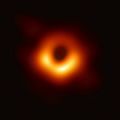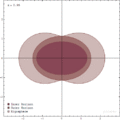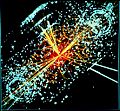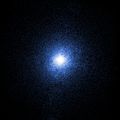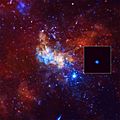Black hole facts for kids

A black hole is like a super strong gravity trap in space. Nothing can escape from it, not even light! This happens because a huge amount of mass is squeezed into a tiny space, bending space and time around it.
Around a black hole, there's a point of no return called the event horizon. It's called "black" because it sucks in all the light that hits it, just like a perfect black body absorbs all light.
Scientists also believe that black holes have a tiny temperature and slowly release energy called Hawking radiation. This makes them slowly get smaller over a very long time.
Astronomers find black holes by looking at how they affect things around them. For example, they can track the movement of stars that orbit a hidden spot in space. If the stars are moving very fast around nothing visible, there's likely a black hole there. Also, when gas falls into a black hole, it gets super hot and glows brightly, sending out lots of radiation that we can detect with telescopes.
Scientists have found evidence of supermassive black holes at the center of almost all galaxies. In 2008, after watching stars for 16 years, astronomers found strong proof of a supermassive black hole at the center of our own Milky Way galaxy, near a spot called Sagittarius A*. This black hole is more than 4 million times heavier than our Sun! Inside a black hole, the rules of physics are very different from what we know.
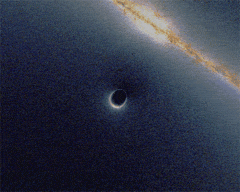
Contents
History of Black Holes
In 1783, an English clergyman named John Michell had an interesting idea. He thought something could be so heavy that you would need to travel faster than the speed of light to escape its gravity. The speed needed to escape gravity is called escape velocity. Bigger planets and stars have stronger gravity, so their escape velocity is much faster. Michell wondered if something could be so massive that even light couldn't escape its pull.
In 1796, Pierre-Simon Laplace shared a similar idea in his book. However, some scientists didn't think light had mass, so they believed gravity wouldn't affect it. Michell's idea was mostly forgotten for a while.
Then, in 1916, Albert Einstein came up with his general relativity theory. This new idea explained gravity in a different way:
- Heavy things (mass) cause space and time to bend or curve.
- Moving objects, including light, follow these curves in space. This is what we feel as gravity.
- Light always travels at the same speed, but it can be affected by gravity.
A few months later, a German physicist named Karl Schwarzschild used Einstein's equations to show that a black hole could actually exist. In 1930, Subrahmanyan Chandrasekhar predicted that stars much heavier than our Sun could collapse when they run out of fuel. In 1939, Robert Oppenheimer and H. Snyder calculated that a star would need to be at least three times bigger than the Sun to form a black hole.
The name "black hole" was first used in 1967 by John Wheeler. Before that, they were sometimes called "dark stars."
In 1970, Stephen Hawking and Roger Penrose proved that black holes must exist. Even though black holes themselves are invisible, the matter falling into them can be very bright.
In 2019, a large team of scientists released the first direct image of a black hole's surroundings. One key person on this team was Katie Bouman, a computer scientist who helped put together many photos from different locations to create the final image.
How Black Holes Form
Giant Stars Collapsing
Most black holes form from the gravitational collapse of very huge, high-mass stars. These are called "stellar mass" black holes. When a giant star runs out of fuel, its core collapses inward due to its own gravity. If the core is heavy enough, it collapses so much that it forms a black hole.
Some scientists think that very massive stars in the early universe might have formed black holes up to 1,000 times the mass of our Sun. These could have been the "seeds" for the supermassive black holes we find at the centers of most galaxies today.
When a star collapses, a distant observer would see the material falling in slow down and appear to stop just above the event horizon. This is because of something called gravitational time dilation, where time seems to slow down near strong gravity. The light from the collapsing star would also get dimmer and redder until it eventually fades away.
Supermassive Black Holes
Black holes are also found in the middle of almost every galaxy in the known universe. These are called supermassive black holes (SBH), and they are the biggest black holes of all. They are thought to have formed when the Universe was very young and played a big role in shaping galaxies.
Very bright objects called quasars are believed to be powered by supermassive black holes sucking in huge amounts of material at the centers of distant galaxies. Light cannot escape the black hole itself, but the energy we see from quasars comes from the super hot, swirling material just outside the event horizon. This material gets incredibly hot due to friction and gravity.
Scientists have measured these central masses to be millions or even billions of times heavier than our Sun. Many large galaxies nearby, even those without a bright quasar, also have a similar central black hole. This suggests that all large galaxies have one, but only a few are actively feeding and glowing as quasars.
How Black Holes Affect Light
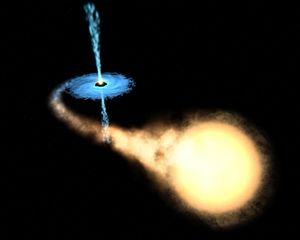
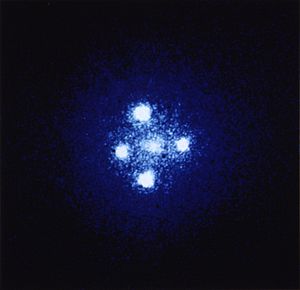
At the very center of a black hole is a point called a singularity. It's impossible to see into it because its gravity is so strong that no light can escape. Around this tiny singularity is a larger area where light that would normally pass by gets pulled in. The edge of this area is called the event horizon. Everything inside the event horizon is part of the black hole. The black hole's gravity gets weaker the farther away you are. The event horizon is the farthest point from the center where gravity is still strong enough to trap light.
Outside the event horizon, light and matter are still pulled toward the black hole. If a black hole is surrounded by gas and dust, this material will form a flat, swirling "accretion disk" around it. "Accretion" means gathering. An accretion disk looks a bit like the rings of Saturn. As the matter gets pulled closer, it heats up incredibly hot and shoots out x-ray radiation into space. You can imagine it like water spinning around a drain before it falls in.
Most black holes are too far away for us to see their accretion disks or jets. The main way we know a black hole is there is by observing how stars, gas, and light behave around it. When a black hole is nearby, even huge objects like stars move differently, often much faster than they would if the black hole wasn't there.
Since we can't directly see black holes, we use other methods to detect them. When a black hole passes between us and a source of light, its gravity bends the light around it, creating a distorted or even multiple images of the light source. This effect is called gravitational lensing.
Hawking Radiation
Hawking radiation is a type of radiation that scientists believe is given off by black holes. It's caused by tiny quantum effects happening near the event horizon. This idea was first suggested by physicist Stephen Hawking in 1974.
Hawking radiation causes a black hole to slowly lose mass and energy. This process is sometimes called black hole evaporation. It happens because of "virtual particle-antiparticle pairs" that constantly pop in and out of existence near the event horizon. Sometimes, one particle falls into the black hole while its partner escapes, carrying away a tiny bit of the black hole's energy.
Because of this, black holes that lose more mass than they gain are expected to shrink and eventually disappear completely. Very tiny black holes, called Micro black holes, are predicted to give off more radiation and disappear much faster than larger ones.
Related pages
Images for kids
-
Direct image of a supermassive black hole at the core of Messier 87
-
Animated simulation of a Schwarzschild black hole with a galaxy passing behind. Around the time of alignment, extreme gravitational lensing of the galaxy is observed.
-
Simulated view of a black hole in front of the Large Magellanic Cloud. Note the gravitational lensing effect, which produces two enlarged but highly distorted views of the Cloud. Across the top, the Milky Way disk appears distorted into an arc. Published in 2019.
-
Gas cloud being ripped apart by black hole at the centre of the Milky Way (observations from 2006, 2010 and 2013 are shown in blue, green and red, respectively).
-
Predicted appearance of a non-rotating black hole with toroidal ring of ionised matter, such as has been proposed as a model for Sagittarius A*. The asymmetry is due to the Doppler effect resulting from the enormous orbital speed needed for centrifugal balance of the powerful gravitational attraction of the hole.
-
Blurring of X-rays near black hole (NuSTAR; 12 August 2014)
-
A Chandra X-Ray Observatory image of Cygnus X-1, which was the first strong black hole candidate discovered
See also
 In Spanish: Agujero negro para niños
In Spanish: Agujero negro para niños


